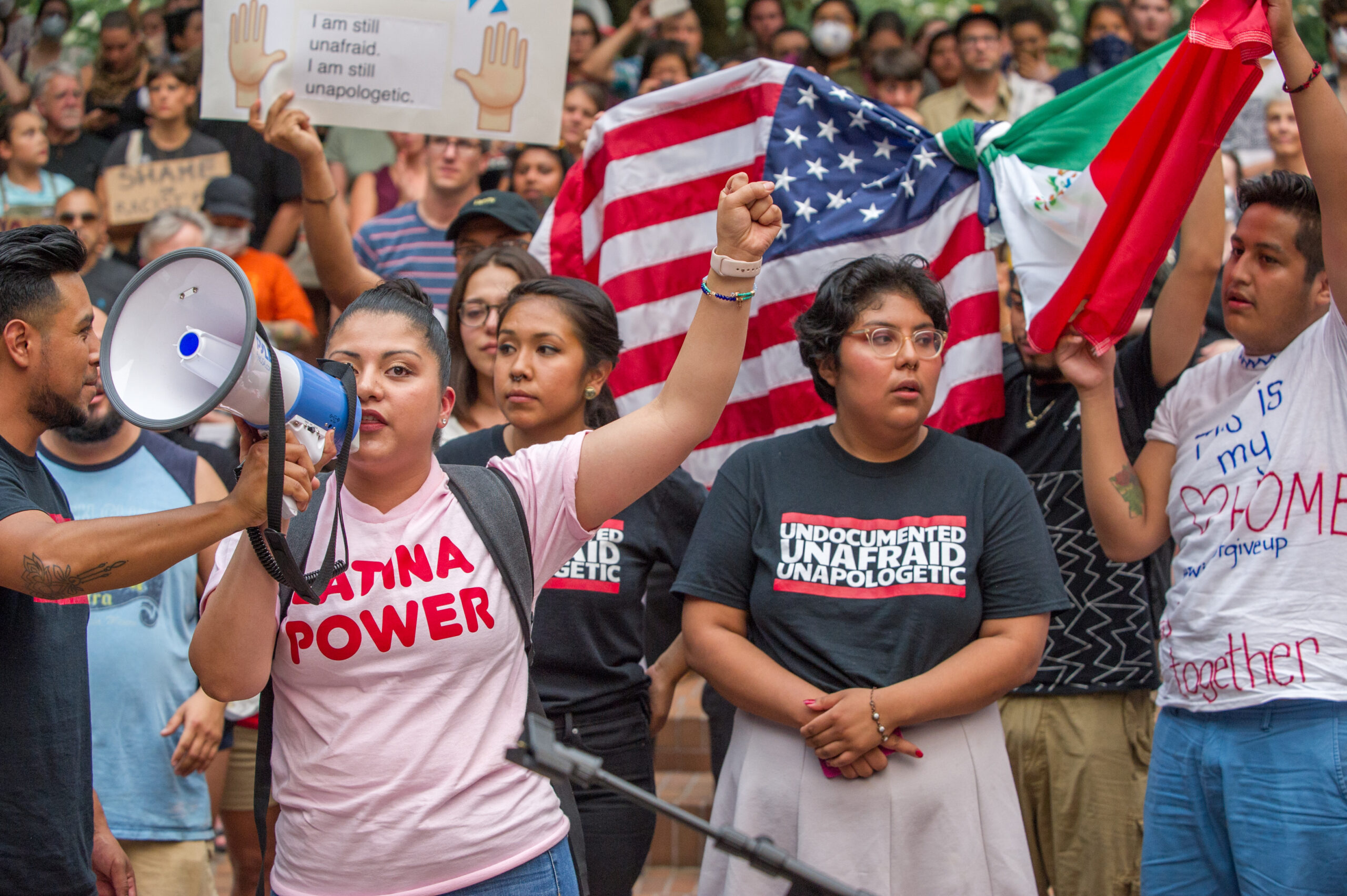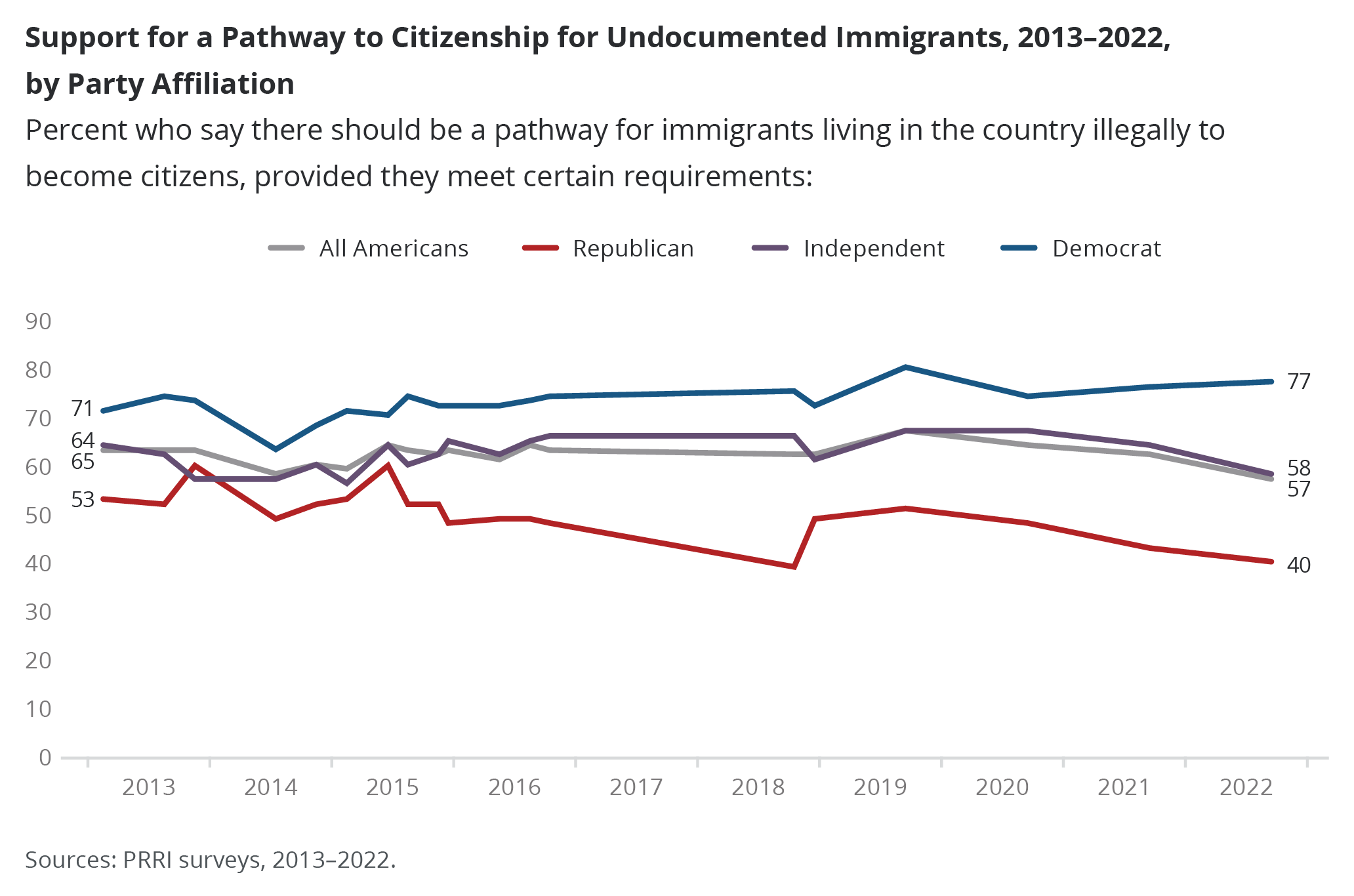The Surprisingly Bipartisan History of Pathway to Citizenship Policies

Americans’ views on policies that provide a pathway to citizenship for undocumented migrants have become increasingly polarized along partisan lines over the past decade. PRRI data from 2022 shows that Democrats have become more supportive of such policies since 2013, with support rising by six percentage points, while support among Republicans has dropped by a whopping 13 points. That said, support for a pathway to citizenship among Americans overall has never fallen under 50% in the past decade, which means that proponents have consistently been able to claim that a majority of Americans support the idea.
Indeed, a longer look backward reveals a history of surprisingly enduring bipartisan support for the policy. This bipartisanship continues to manifest occasionally, including in a recent immigration bill sponsored by Sen. Thom Tillis (R-NC) and Sen. Kyrsten Sinema (I-AZ) at the end of the last Congress. The bill would provide a pathway to citizenship and regularize status for hundreds of thousands of undocumented immigrants who are currently in the United States under Deferred Action for Childhood Arrivals (DACA), an interim policy enacted by President Obama in 2012, which stops short of allowing citizenship. However, the Tillis-Sinema proposal combines the pathway to citizenship with a number of draconian provisions that strengthen border control and extend Title 42, a Trump-era measure that allows for the expedited expulsion of migrants at the border on public health grounds, which was set to expire but has been kept in place by the Supreme Court.

DACA has its roots in a bipartisan Senate bill proposed by Sens. Dick Durbin (D-IL) and Orrin Hatch (R-UT) in 2001, the DREAM (Development, Relief, and Education for Alien Minors) Act. The DREAM Act would have created a pathway to citizenship for undocumented minors who had been brought to the country as children if they attended college or served in the military for at least two years. It was widely expected to pass, but then a national crisis intervened. The votes were lined up, and Tereza Lee, a Brazilian-born Korean American music student whose story had inspired Durbin to introduce the bill, was en route to Washington on Sept. 11, 2001, to play piano at a celebration planned to mark the legislation’s passage. But after the attacks on the Twin Towers and the Pentagon, the government cracked down on migration as national security became the top national priority. In this climate, the DREAM Act was rendered politically untenable. Though it was reintroduced at least 10 times over the next decade, the legislation never again found purchase. It would require a 2012 executive action by President Obama, creating DACA, to implement even a semblance of the DREAM Act’s vision. Instead of creating a path to U.S. citizenship, DACA offered those who qualified for the program a temporary reprieve, allowing them to attend school and work without fear of deportation or punishment. Two years later, the Obama administration attempted to enact another program, called Deferred Action for the Parents of Dreamers, which would have extended deferred status to the parents of DACA recipients, but the Supreme Court struck down the president’s executive order before it went into effect.
Republicans were highly critical of Obama’s use of executive orders on this issue and others, but they showed some willingness to reconsider their opposition between 2012 and 2016. The party’s thinking shifted in the wake of Mitt Romney’s defeat in the 2012 presidential election and the now-infamous “autopsy report” calling on the GOP to be more attentive to the concerns of an increasingly diverse electorate. In the Senate in 2013, the bipartisan “Gang of Eight” proposed an immigration overhaul bill that included a pathway to citizenship for undocumented migrants. The future presidential primary contender Marco Rubio was among this group of senators. To be sure, he received a good deal of criticism from conservatives, both at the time and in the 2016 presidential primary, and he conditioned his support on including increased border security in the legislation. But Rubio’s support reflected a softening, however fleeting, of Republican hardline stances.
Three years later, Donald Trump helped stoke American nativism and bring it into the mainstream. Alarm about DACA was at a fever pitch at the time of Trump’s rise and election. Within a year of taking office, Trump carried out his campaign promise to end DACA. But DACA status and renewals continued as appeals moved their way through the courts, as did debates over the policy. In January 2018, the battle over DACA led to a three-day government shutdown. In June 2020, against the backdrop of the presidential race, the Supreme Court ruled against Trump’s action on procedural grounds, citing a lack of adequate rationale. Writing the Court’s majority opinion, Justice John Roberts called the Trump administration’s actions “arbitrary and capricious.” These reprieves notwithstanding, there are other ways DACA opponents could end the program, and, as of this writing, many observers say the demise of DACA is just a matter of time.
It is unclear how far the Tillis-Sinema immigration bill might go. With a new Republican majority in the House and a Senate under more secure Democratic control, time will tell whether the pathway to citizenship will again be dead in the water.

